Op. 7 Kullervo Symphony for soprano, baritone, male voice choir and orchestra. 1. Introduction, 2. Kullervo's Youth, 3. Kullervo and his Sister, 4. Kullervo goes to War, 5. Kullervo's death; words from Kalevala. Completed in 1892; first public performance 28th April 1892, Helsinki (soloists Emmy Achté and Abraham Ojanperä, Orchestra of the Helsinki Orchestra Society under Jean Sibelius). Arrangement for baritone and piano of part of the music (Kullervo's Lament) 1893, revised version 1917-18. Arrangement for baritone and orchestra of part of the music (Kullervo's Lament) 1957; first performance on 14th June 1957 in Helsinki (Kim Borg, the Finnish Radio Symphony Orchestra under Jussi Jalas).
Jean Sibelius started to think up ideas for Kullervo in Vienna in the spring of 1891, in his student flat at the corner of Wiedner Haupstrasse 36 and Waaggasse 1.
He was studying under Robert Fuchs and Carl Goldmark, but his teachers were not enthusiastic about his first attempts at orchestral works. Goldmark thought that Sibelius's first work was badly orchestrated. According to Fuchs the ideas he produced after this were also "barbaric and raw". This made the composer's Finnish blood boil. So, let's be barbarians!
Sibelius became absorbed in Kalevala and found in it exciting rhythms and fascinating variations on themes – materials for a new kind of music. Sibelius himself had mentioned "a new, Finnish type of song", referring to his setting of Runeberg's poem Drömmen. From now on, his style would include "that melodious, strangely melancholic monotony which is in all Finnish melodies".
On 3rd February 1891, on the first floor at Waaggasse, Sibelius was burning the sketches which he had written in a more German style and "laughing scornfully". He was starting to work on a symphony, and as late as the beginning of April he was writing a finale which "begins with a recitative which actually takes an upward curve into the last movement: variations on a theme handled in the Finnish manner, a free treatment". However, in April he heard Richter conduct Beethoven's ninth symphony and felt "so tiny, so tiny". The symphony came to nothing.
Sibelius was not discouraged. He started to write a new "symphony" - as he called the work to begin with and often even later. Sibelius took the subject matter from the Kullervo saga in Kalevala. In this a young man seduces a woman without knowing that she is his long-lost sister. Both end up committing suicide.
In a letter to Aino, Sibelius wrote that he had initially discarded at least 50 themes. He had obviously paid attention to the advice of his teacher, Goldmark, about the need to craft his themes carefully. Finally he came up with a theme that he was satisfied with. A prototype of the main theme of the first movement of Kullervo had taken shape. The theme can be found the letter Janne sent to Aino on 18th April 1891, even if it is still in F major.

"I am trying to find out what my symphony is all about. It is so different from everything that I have written so far," Sibelius wrote concerning his thematic sequence. Two days later Sibelius wrote to Aino that Fuchs had been enthusiastic about the new Kullervo theme.
Sibelius worked on the first movement for a long time. Apparently he continued to prepare it in the summer of 1891, first on his return from Vienna to Finland and then after he settled down to compose in Loviisa during the autumn. Right at the end of the year Sibelius acquainted himself with the art of Larin Paraske, a Finnish singer of runes, in Porvoo. Yrjö Hirn later recollected the meeting.
"I was travelling with Jean Sibelius from Loviisa via Porvoo to Hämeenlinna. At that time my travelling companion, who was five years my senior, was developing plans that would result in the symphonic poem Kullervo, which was completed and performed the following year. He was very eager to hear what Karelian runes sounded like when they were sung by a genuine Karelian singer, and I was of course glad to be able to witness this encounter between the new and the old. I dare not speculate what it meant for the compositions the master based on Kalevala, the fact that he could listen to Paraske just then. I just remember how he followed the song attentively and wrote down the melody and the rhythms."
In his old age, Sibelius told his son-in-law Jussi Snellman that he had been a good deal more sceptical.
"Kullervo had been composed in the summer and autumn of 1891. When it was completed I went with Hirn to Porvoo to see Paraske. There was not much snow on the ground but it was already very cold. At the time I had no idea what a celebrity was sitting in front of me. In her singing I mainly paid attention to how such a 'rune singer' uses Finnish: 'murehiaa-aa-aa', 'musta lintuu-uu-uu', in other words, especially the way they prolong and stress the last syllables of a word. To my ears the stress that Paraske used sounded very strange, and I had no idea that I was dealing with such a great master, since I did not find her such an extraordinary rune singer. In 'Kullervo' I had used a natural stressing of syllables. Later I followed Paraske's way in poems with the Kalevala metre, e.g. in 'Väinämöisen venematka' (Väinämöinen's Boat-ride)."
Sibelius's memory was faulty when he claimed that Kullervo had been completed before the meeting with Paraske. He returned to Loviisa for Christmas, continued to compose Kullervo and wrote down the theme for the second movement in a tender love letter that he sent to Aino on 29th December 1891.
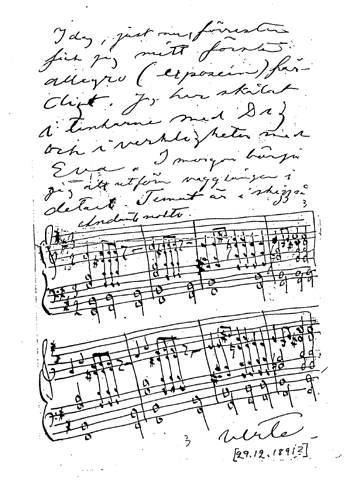
From the end of January 1892 the composing continued in Helsinki, at the Kaivopuisto bathing establishment. At the beginning of March Sibelius decided that the choir should be a male choir. He took the view that the scene in the third movement depicting sexual intercourse - though shown by purely musical means – would embarrass female singers. "You, my dear, will understand," Sibelius wrote to his fiancée.
The rehearsals started at the beginning of April. Juho Ranta, who sang in the choir, recollected the events in 1933.
"There were not that many general rehearsals. All I can remember is that the 'official' language of the orchestra was German, most of the musicians being foreigners. Although my skills in German are very modest, I was proud when after hearing: 'Bitte, noch einmal vom Buchstab X', I could explain to my comrades, who only spoke their own language, that we should now repeat from some point or another."
The soloist Emmy Achté later wrote to her daughter that the orchestral rehearsals had been awkward.
"Yes, I will never forget the first rehearsal with the orchestra, when after my first recitative the members of the orchestra started laughing uncontrollably, splitting their sides."
28. The first public performance was on April 28th 1892 with Emmy Achté and Abraham Ojanperä as the soloists. The composer's hands were shaking and he looked pale, but the energy of the performance immediately gripped a section of the audience. "It was like a volcanic eruption," Axel Törnudd recollected. "Most of the listeners considered it complete chaos."
It was not until Robert Kajanus presented a wreath to Sibelius that the applause grew louder. This did not prevent the columnist Leonard Salin (under the pseudonym Boulot in Hufvudstadsbladet) from sneering that he had no idea at what point the orchestra stopped tuning up and the music began.
There was an element of language politics in all this. It was clear to the “Fennomans” that Sibelius had now joined their ranks. For their part, the "Svecomans" were disappointed in Sibelius, whose mother tongue was Swedish.
The Finnish-speaking composer and critic Oskar Merikanto wrote of his uncertainty about the work (in Päivälehti, 29th April). He conceded, however, that the composer had "taken a long step forward with this work and, at the same time, taken Finnish art towards a highly promising future." He continued: "The whole composition is, due to its Finnish content, the most impressive and powerful work ever to come from a Finnish pen."
The Swedish-speaking critic Karl Flodin praised the work with reservations: "Jean Sibelius has a tune of his own, it is a gift originating from great abilities, and with it he writes his own, our own music." According to Flodin Kullervo's modulations, rhythms and melodies had their origin in Finnish folk songs. Flodin also predicted that
Kullervo would be the end of a road. "If Sibelius wanted to write a new symphonic poem, for instance a depiction of Lemminkäinen, he would have to find a completely new perspective in order not to repeat what he already has said in Kullervo."
The introduction of the work (Allegro moderato) begins with an ominous distant humming in the strings. Above that the clarinets and the French horns play a kind of destiny theme.
The strings take over the theme and the atmosphere lightens for a moment. However, the French horn gives us a hint of the inevitability of fate in a subsidiary theme. Sibelius is already making use of the augmented fourth in the same way as in the fourth symphony.
The introduction progresses in sonata form. In the development one can hear references both to Finnish rune singing and to Bruckner. When the main theme finally returns, the power of it, played by the brass and woodwind, is stunning. The lighter E major atmosphere presented in the development turns out to be temporary.
Oskar Merikanto found the introduction fragmentary, though he admitted that the progress from the Overture in E major and Scène de Ballet was truly astonishing. Robert Layton observed that in this movement Sibelius showed an "inborn talent for symphony". Erkki Salmenhaara has noted Sibelius's own comments about "not going into details". Salmenhaara describes how in this movement the composer "paints with broad strokes the dark, ominous background of the Kullervo drama".

The first page of the manuscript of Kullervo
The second movement, Kullervo's Youth, is the most unified and enduring section of the work, even if its dramaturgical positioning is unusual. The movement resembles a second "introduction" to the drama. At first the strings play a "lullaby motif", whose soothing rhythm later becomes violent:

The first page of the second movement of Kullervo
Erik Tawaststjerna has described the structure of the second movement as A-B-A'-B'-A'', whereas Erkki Salmenhaara separates three thematic elements: besides the lullaby theme he identifies a rune-singing theme and a shepherd theme. Salmenhaara bases his analysis of the general structure on these elements.
In the manner of rune singers Sibelius varies his themes rhythmically and melodically, combining ideas from each one; thus it is not surprising if analyses differ from each other. Tawaststjerna sees the movement as looking forward to The Oceanides, while Salmenhaara finds in one episode an astonishing resemblance to Stravinsky's Rite of Spring, composed a few decades later. Robert Layton emphasises the Tchaikovskian influences on the movement.
Perhaps Sibelius himself gave the best description: he called the movement a lullaby whose "intensity is increased through variation". The increase in intensity is violent and fierce, and the lullaby atmosphere disappears completely.
It is not until the third movement, over thirty minutes from the beginning of the work, that the male voice choir and the soloists make their voices heard. The time signature in the movement Kullervo and his Sister is the typically Finnish 5/4. The orchestra creates the atmosphere and finally the choir begins the story: Kullervo, son of Kalervo, son of an old man, wearing blue stockings. The archaic atmosphere is accentuated by male voice choir, which sings in unison.
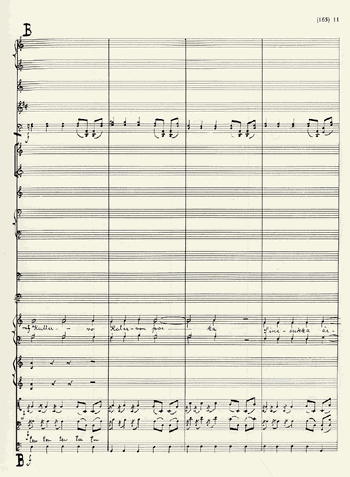
The first page of the third movement of Kullervo
The text, which is from the Kullervo saga in the Kalevala epic, goes through the basic story: Kullervo persuades a young woman to enter his sleigh and induces her to yield herself to him in exchange for material goods. This is followed by an episode of unrestrained love-making, shown by orchestral means. It ends in a violent outburst, after which the sleigh atmosphere returns and the vocalists can make their voices heard. Sibelius had an absolute mastery of the Finnish language. In the part "Reki rasasi" the syllables are not stretched out in a way that does violence to the normal language, as had previously been the practice of composers in Finland.
Now the consequences of the sexual act are presented. It is revealed that Kullervo has unknowingly seduced his long-lost sister. This is followed by the sister's song of lamentation - masterfully written - and finally the high drama of Kullervo's Lament. The work would seem to end here.
But no: there is a surprising fourth movement, Kullervo goes to War (Alla marcia). Its cheerfulness and heroism seem to come from an entirely different world, even if the piccolo trills at the very beginning do give some sense of violence.

The first page of the manuscript of the fourth movement of Kullervo
In this movement - a rondo, but freely-treated - Sibelius has taken literally the words of the text, "went off piping to the war, went rejoicing to the battle". Tawaststjerna and Salmenhaara argue that the Karelian and Russian tones in the movement even anticipate Stravinsky's Petrushka.
The male voice choir re-enters with the fifth movement, Kullervo's Death (Andante). Most of the musical material comes from the introduction (the recapitulation section). The circle seems to close when the fateful main theme returns.
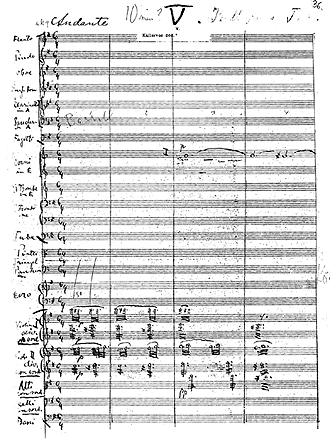
The first page of the manuscript of the fifth movement of Kullervo
Kullervo, who has returned from the battlefield, is looking for the place where he defiled his sister. As if to conjure up destruction, the choir presents a dialogue between a sword and a swordsman: Would it please this blade to eat guilty flesh and to drink sinful blood? The sword answers: Why should it not please me to eat guilty flesh and to drink sinful blood? Since I eat the flesh of the guiltless and I drink the blood of the innocent."
The sound of the choir is now something close to raw screaming. But there will be one last hasty crescendo, during which the hero throws himself on his sword. The choir's final sentence is laconic: Thus was the death of the young man, the end of the hero, the death of the ill-fated one.
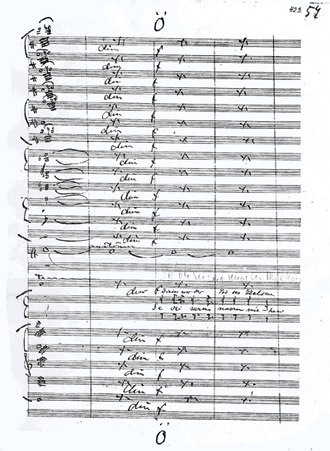
The first page of the last movement of Kullervo
What was the reaction of Sibelius's contemporaries? Merikanto wrote: "And when the orchestra is in a stormy rage, when it caresses dissonances and finally falls silent with a forceful chord, one somehow feels relieved, now it has happened. But the choir has not fallen silent yet: it goes through the events and it does this in a horrifying way."
The last bars contain the whole brutal rage of a young man.
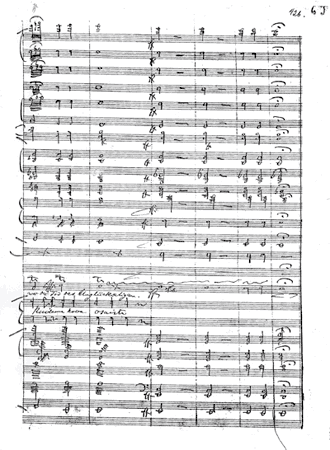
The last page of the manuscript of Kullervo.
Sibelius conducted his work only a few times. The last performances were in 1893, when the critics surprised him with a broadside of scathing criticism. Even Merikanto now considered the orchestral parts too long drawn out.
The composer was shocked and he never conducted the work again – nor did he let anyone else conduct the entire work during his lifetime. One reason that the work was not performed may have had to do with the score getting lost. But when Sibelius did get the score back he had already grown out of the style of the work. "Kullervo was a treasure house," he said in his old age, but he thought that the house had been emptied long ago.
Today it is possible to take a different view of the work. In the hands of first-class modern conductors, the clumsy aspects convey an exciting roughness. In the 1990s there was a veritable flood of Kullervo recordings, and at the beginning of the 21st century the work continues to be a popular item for Finnish orchestras to take abroad.
Kullervo is at the same time a masterpiece and a baggy monster of a work, bursting at the seams. It is the King Kong of orchestral composition. Its brutality and massive size command fear and respect, yet it is at heart a romantic work.
After the completion of Kullervo Sibelius could proceed in only one direction: towards greater concentration and a more consistent symphonic form. The critic Karl Flodin was right. Kullervo was not the start of a road; it was the end. Never again would Sibelius create anything as brazenly megalomaniac.

